Note
Didn’t realize that you were still on here but I just wanted to say that I’ve always loved reading your thoughts on Indian film!
thank you <3
If anyone is reading this, then wow - what a few years it has been for the cinema of India right? Maybe I'll write about it soon...
5 notes
·
View notes
Note
found ur blog too late but I love it nonetheless. if u ever see this thank youu<<333
thank you too! I might post a rundown of movies I loved in the last however many years its been....but let’s see.
1 note
·
View note
Note
Can you recommend me romance movies,like not the cheesy cliche ones but angsty or realisitic one's,where people actually struggle and real life and goals&objectives.
Ooooo angsty! My fave word.Go for:ManmarziyaanNeethaane En PonvasanthamArjun ReddyShudh Desi RomanceCocktailPyaar Prema KaadhalVinnaithaandi VaruvaayaaMayakkam Enna7/g Rainbow ColonyAadavari Matalaku Arthale VeruleAnd yes. I REALLY like Selvaraghavan.
2 notes
·
View notes
Note
have you seeen Aruvi? I feel like you might like, and I feel like it's so underappreciatedd -- that one and Enakkul Oruvan, I think you should watch if you haven't
Aruvi is a stunning film! I've seen both Enakkul Oruvan and the Kannada original Lucia, and as much as I love Siddarth, nothing can beat the frenetic DIY scrappiness of Pawan Kumar's version.
2 notes
·
View notes
Text
My favourite Indian films of 2018
Sorry for the wait this year. 2018 in the movies mirrored my own life a lot; the films on the list are films to love, make you feel something human, and they force you to take their characters and hold them close to your chest as if they were your own. While the most interesting mainstream movies from South Asia over previous years on this blog have excelled when they chose to experiment with the language of cinema itself, the 10 I’ve written about here have, similar to great literature, embraced pain, longing, love and everything else that comes with being alive.
10. Theevandi
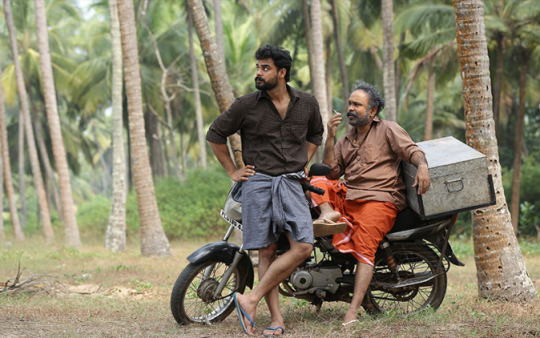
I’ve seen this film being described as an “anti-smoking movie.” I couldn’t disagree more. It’s a story about the nature of habit (rather than the disease of ‘addiction’), of locating the source of your personality, your soul, and trying to change it against the will of nature. During my time in India this year, nothing brought more joy than an ice burst and cutting tea at the side of the road, perching on the side of the pavement and watching life carry on around you. And while this is a film with a main character who wants to quit smoking, it isn’t about cancer. It isn’t about that horrible sooty smell at the end of your fingers, or yellowing teeth or a decreased sperm count. It’s about how something as innocuous as a tube of rolled up tobacco hanging out of your mouth can act as a fragile crutch for the entire weight of the world.
9. Laila Majnu

Like many of my favourites this year (and every year), this re-telling of one of South Asia’s most important romances wants to know what love is. Here, we see love not as a generous, giving emotion, but as pure greed. With one of Bollywood’s most gorgeous soundtracks, that bleeds furiously out of every frame, and a constant sparkling gleam of glamour over these gorgeous young actors and the Kashmiri hills they prance around in, I enjoyed this enough just based on the commercial tropes it toys with for fun. But its real beauty lies in its brave and painful final declaration; that the most divine love may connect you to God and remove your soul from your body, but it will destroy you and your connections to the Earth, as the cruelest form of asceticism.
8. Cake
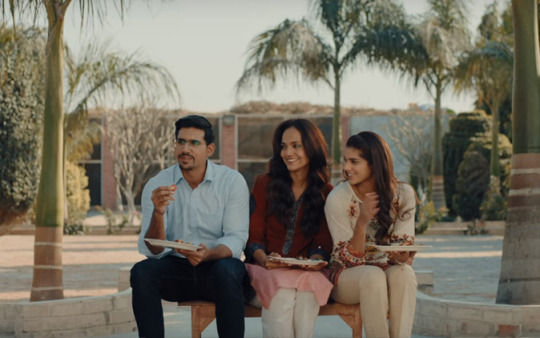
I’m including a Pakistani movie (again) because our film industries were birthed under one national identity, and I don’t see the studios of Karachi as any more culturally distant from Mumbai’s Film City than Kodambakkam. Moving to Cake, this stunning portrait of a dysfunctional family surprised me against all my instincts that it was a Western-facing production clearly aimed at piercing its way into festivals and a patronising ‘World Cinema’ bracket. It is in fact, a study of shifting societal politics in an increasingly extreme and polarised World, of figuring out where your values stand in the midst of religion, feudalism and globalisation, and accepting that when these heavy, abstract concepts weigh down on your shoulders, it is the human beings around you who will feel the strain first.
7. Golak, Bugni, Bank Te Batua
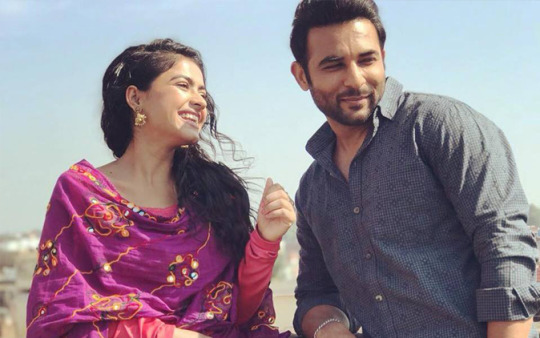
I really love Punjabi cinema. Seeing it come into its own and reclaim its cultural narratives and aesthetics from bastardizing Bollywood (where now even a film set in rural Gujarat will feature a Punjabi language song) has brought a lot of joy. Now here comes a happy little film not set on preaching the glory of Sikkhi or telling an epic tale of brave warriors or earnest farmers, but on bringing us into the lives of a middle class Hindu Punjabi family in a small mohalla of a tier 2 city. And these aren’t the Hindu “Punjabis” of a Bollywood movie set in Chandni Chowk, who might throw in a “tussi” or “tuadi” here and there at the most. These are real people with a real culture, as intertwined with Punjab and their Sikh neighbours as they are separate. The film doesn’t patronise them by drawing humour from their novel identity; the situational character-based slapstick and witty back-and-forth theatrical dialogues exist in a warm parallel with the “World” of the movie. And then the lives of these people change in one instant as demonetisation hits, and we are hilariously reminded that whether you’re Hindu or Sikh, Northern or Southern, you are (unfortunately) still in India.
6. C/o Kancharapalem
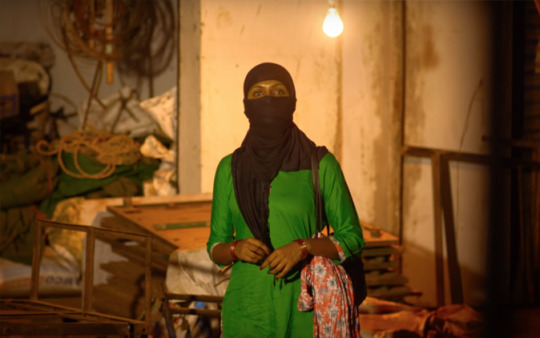
I won't say this film stood out as a "Telugu movie", as such slight, subtle films are an anomaly no matter what language they're made in or how brash those other films produced in the same mother tongue may be. These small and quiet tales, with their shy characters who live at the fringes of society, whether that mean they are Muslim prostitutes or simple middle class teachers carving out a living in a small village, are special because they manage to transmit such humanity without stirring from the dark alleyways or shaded courtyards where they take place. Not every film needs to stand tall like an intimdsting Tolstoy tome; some can be as unassuming as an RK Narayan novella and still make us feel like they're an epic.
5. Pyaar Prema Kaadhal
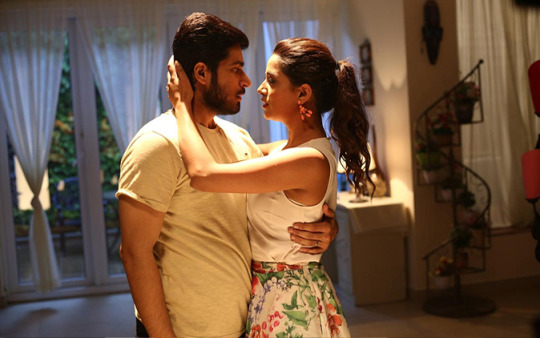
Let's be honest. Casting two leads from a reality show, putting heart shaped balloons in your posters and deciding on the title "Love, Love, Love" pretty much screams "trash" doesn't it? But here was a humbling reminder that Indian popular culture can surprise you in the most pleasant of ways. These two good-looking young wannabe-stars and their social media followings represent so much about the "new India", a steadfastly singular culture (or cultures) whizzing through the fiery hoops of globalisation at breakneck speed, coming to terms with a mixed up value system, raging sexual frustration and an ever widening class gap, all of which have left a generation feeling more connected yet more alienated than ever before. This is 'Pyaar, Prema, Kaadhal', a flawed and horny love story, sweating with tension and all the repulsive angst of human emotion, yet with the glamorous musical heart of Indian cinema still beating loudly underneath.
4. Manmarziyaan

There was as much to love about 'Manmarziyaan' as there was to hate. The age-old filmi love triangle rears its head again, only this time with characters who are more manipulative and frustrating than any you've seen in a "mainstream" movie before. But while the film never forces you to judge (at times leaving you confused about whether you're actually supposed to like any of these people) it demands that you engage. It's encouraged some of the finest writing on cinema I've seen in recent years, and such an unashamedly "Bollywood" film inspiring this thrilling thought and analysis from our finest critics (whether their judgement is kind or not) warrants its inclusion on this list alone. Then there's the way its incredible soundtrack weaves in and out of scenes like the characters own breaths, the way life changing moments are obscured from the script by deafening silences and acutely observed minutiae, and of course THAT lead performance. I'm not sure if I "liked" it or not, but I sure as hell can't wait to watch it again.
3. Pari
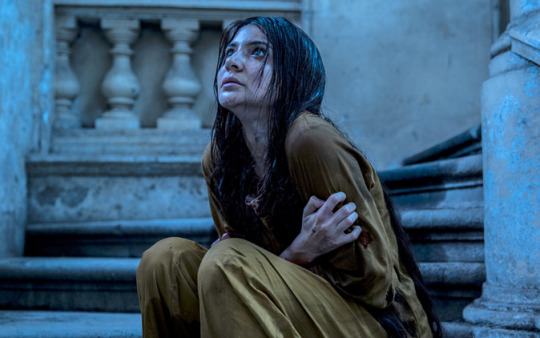
The better the film, the harder it is to write about. 'Pari' is rich with metaphor. While being a ghost story (and a damn good one) merely on the surface, it has plenty to say about the way our society treats women, poses the question of if we can truly be born evil, and even critiques our savage treatment of "the other" in a global society where more of us are on the run than settled in our homes. But I think its biggest strength is that while it challenges you to reach into the very centre of your being and take a look at yourself and the World around you, its craft and screenwriting is so good that not at any moment does it give you a second to realise that's what you're doing.
2. Rangasthalam
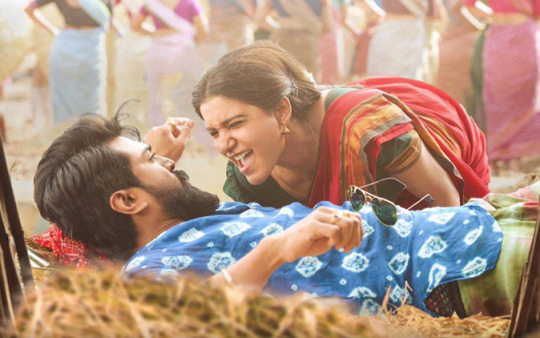
'Rangasthalam' is so great. Like really really great. Once an innocuous muscle man, Ram Charan has channelled his inner Dhanush and located his physicality, writhing and slanging his way into the mind and body of the quintessential South Indian rural hero, hoisting his lungi and flicking his beedi into one of the most visceral and truly cinematic masala movies in living memory. The thumping pace and kinetic choreography (both of the rousing song sequences and the busy, lived-in frames of the rest of the movie) evoke a dusty, violent world with the same panache of Ameer in 'Paruthiveeran' or Sasikumar in 'Subramaniyapuram', while the moustache twirling dialogues and meticulous emotional beats offer as much pure fun as a "Dabangg" or a "Khakee" or any classic Hindi masala movie. I've read pieces linking the cinema of 'Rangasthalam' to film noir traditions, but to me it simply proved that the masala genre still has as much excitement to offer as any other.
1. Mukkabaaz

I'll remember 2018 as the year that Anurag Kashyap, previously India's frontrunner in the realm of "interesting" (but more often headscatching) cinema, stopped thinking with his very big brain and instead used his even bigger heart. His most straightforward film is undoubtedly his best, Hollywood-esque in its writing but firmly Indian in its sentiment. The scale is small - empty boxing arenas, bleak winding village paths and a cast plucked from the TV screen - but its emotions are pure opera. This is a timeless film, and though it laughs at the ridiculousness of modern India, poking a nasty smug finger at caste oppression, petty politics and the bureaucratic nightmare of simply trying to stay alive, it defies analysis. Much like the song at the centre of the story, the violently stunning 'Paintra', it only asks that you feel. And what more could we want from cinema?
I've had so much fun at the movies this year. From dancing to Dilbar in the cheap seats of G7 in Bandra to reciting Dhanush's Maari 2 dialogues at the bus stop outside Ilford Cineworld, Indian movies have continued to punctuate my life and bring me more joy than they have any right to. I can't wait to do this all again this year. What were the films that stirred you over the last 12 months? Let me know. Xx
#tovinothomas#malayalam#mollywood#indian movies#telugu#tollywood#laila majnu#bollywood review#bollywood#anushka sharma#taapsee pannu#tovino thomas#manmarziyaan#anurag kashyap#indian cinema#ram charan#rangasthalam#pari#mukkabaaz#pyaar prema kadhaal#raiza wilson#tamil#kollywood#punjabi cinema#punjabi movies#punjabi#pakistani cinema#abhishek bachchan#simi chahal#hindi cinema
314 notes
·
View notes
Note
Hi! I'm new to indian film and I'm hoping you could give some recs? To be honest I'm really looking for romcoms (hollywood seems to no longer make these and im turning to other countries to feed my insatiable need for fun romance. Ive also watched a lot of korean dramas lately...) but if there's things in other genres you recommend i'll check those out too! I'll watch pretty much anything :D Thank you!
Hi!!Thanks for getting in touch. In terms of Hollywood/Korean style romcoms, some of my faves are:Shudh Desi RomanceVinnaithaandi VaruvaayaaCocktailNeethaane Enn PonvasanthamPyaar Prema KadhalManmarziyaanO Kadhal KanmaniPremamAll of these are warm, witty and messy romances that constantly strive to challenge the confines of commerical Indian cinema.
4 notes
·
View notes
Text
THE MOST INTERESTING INDIAN FILMS RELEASED IN THE YEAR OF 2017
Another year another list, eh? Sorry I’m a few days late but I am finding it increasingly hard to write about cinema. What is there left for me (or anyone) to really say? The films in these lists of mine are almost always rooted in working-class or subaltern politics (even if only in some small way), fraught with intense emotional and sexual character conflicts, but still imbued with the musical aroma of commercial Indian cinema. So looking back on 2017, I no longer find it a marvel that India (and Pakistan) continues to create this curiously poetic brand of cinema that you can’t find in any other film industry. I just feel happy, fulfilled and excited to see what strange creatures 2018 can throw up. Enjoy!
10. Solo

An undeniably ridiculous film where four short stories, shot in four different styles, each end with the most overblown, left-field, mind-melting twists you could possibly fathom (even one involving a great bit of comedy incest). Though it’s impossible to say if the filmmaker intended it to be this hilarious, one feels lucky that Indian cinema still has auteurs who dare to challenge and assess the grammar of cinema itself (including a certain Anurag Basu, whose film Jagga Jasoos unfortunately didn’t find space in this list). Sometimes they fail, sometimes they soar and, in the case of Solo, sometimes they just show you a really great time.
9. Thupparivaalan
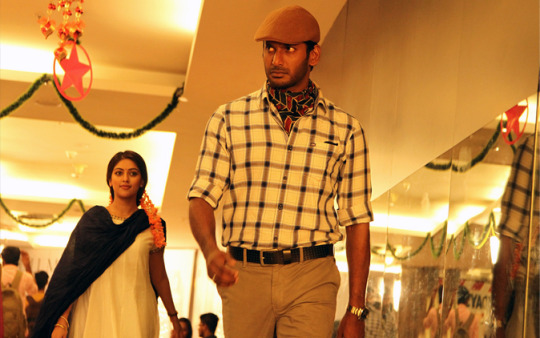
It’s never been more thrilling to see an artist like Mysskin give up experimentation. Now that his years of throwing everything at the camera and seeing what sticks have ended, he is focusing on making great narrative films, that just happen to be full of his odd motifs and auteurial obsessions. This Tamil Sherlock-esque thriller, which feels oddly like a period drama smacked in the middle of the modern day’s claustrophobic shopping-center culture, seems to be interested in the transfer of wealth, the exchange of money for humanitarian services; the poor girl who becomes a servant to repent for her pick-pocketing, the privileged child who hands over a huge sack of pocket money to a grown man, the group of disheveled street kids who have notes thrown out to them, hands aloft, after they dig a deep hole on a beach for a curious detective. This is a film about compassion, about finding help from fellow humans in the midst of capitalism’s all-encompassing crush. There’s also some kung-fu, some disembodied limbs in a fridge...and I think I even spotted a saree with a yellow trim. Mysskin will be Mysskin.
8. Karsandas Pay & Use

2016 was without a doubt the year that brave films about caste defined Indian movies, but this year we had another worthy addition. In a story that could only come from regional cinema, a man who owns a public toilet purposefully blocks a domestic latrine so that the family’s beautiful daughter will have to come and shit in his fine establishment every day. This may not sound like a recipe for political statements on the nature of caste (and indeed there are a lot of great poo jokes throughout), but the treatment of our most natural bodily product is, shamefully, one of the foundations of caste oppression. This film does through humour what Sairat and Kammattipaadam did with serious drama last year. And it’s a Gujarati film! Who cares about the death of Bollywood...
7. Oru Mexican Aparatha
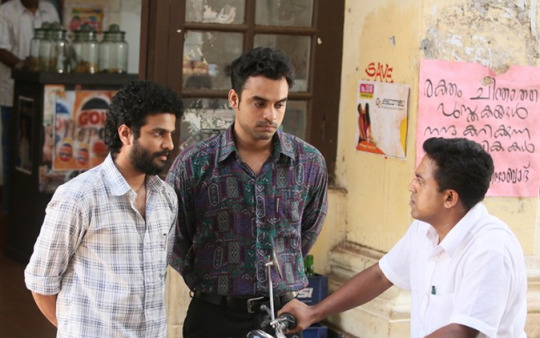
Malayalam cinema continues to make great movies in its own curious genre it’s created over the last decade; films with incredibly detailed character arcs that focus on the mundanities of everyday life, with little “narrative” drive. In OMA, though the stakes appear high (two warring campus political parties violently contest elections in an Indian state where life and politics are one and the same), the detailing is in the people; their hopes and dreams, their fuck-ups, their friendships. Shot with a breakneck speed and intensity that doesn’t leave you looking at anything for very long but still leaves you with an understanding of every single character, big or small, perhaps the most radical thing about this overtly political film, is that it never discusses politics.
6. Punjab Nahi Jaungi

The first Pakistani film that has made it to one of these lists, but for good reason. Films from “emerging” (or more accurately “re-emerging”) film industries, especially in South Asia, seem to adopt certain tropes from popular cinema (ie. songs, melodrama, action) before understanding the craft in writing and direction that makes these tropes stick emotionally. Well the new Pakistani cinema has arrived, and Punjab Nahi Jaungi is a richly textured character epic, with a classic filmi love triangle that reflects modern Pakistani societal issues with great nuance and insight (feudal politics and values, class difference, the treatment of women, caste) without ever compromising its script. It’s no wonder that the “help me Durdana” dialogue became so iconic around the World this year; funny, pathetic, relatable, but also it’s a man begging his own cousin to have sex with him because he’s too horny to wait to marry the woman he loves. Like I said, brilliant characters with a lot of subtext.
5. Fidaa

In many ways Fidaa is nothing new or remarkable. An adequately directed melodrama (with a lot of Soap-style staging) about a spoiled NRI boy returning to his ancestral village, with some nice songs and green scenery. Yet like Punjabi Nahi Jaungi, the script rises above this. We believe these people, we understand them, and the filmi silliness that the movie throws at us in its second half works because of this. Then there is the most important ingredient that made Fidaa work for me: Sai Pallavi (I really love her a lot). The film revolves around her performance (and female POV), and she plays it with so much energy, so much care for her material, so much genuine conviction, you’d swear she wasn’t acting at all (the heartbreaking scene where she wears a western dress to impress the NRI crowd is one of many standouts). So while other elements may wobble around her, Sai Pallavi truly shines in one of the year’s most important and overlooked “female-orientated” (I hate that phrase) movies. Please don’t do a Nazriya and get married and disappear.
4. Nikka Zaildar 2

The first part in this series, though from the director of Angrej (my favourite Punjabi film ever made), was an excruciating rom-com with no energy and no purpose. Here, Simerjit Singh returns to the type of film-making of his best work. At first, NK2 appears to be a hugely populist slice of old-fashioned romantic melodrama. Then the film-making takes thrilling detours. A vintage Mohd. Sidiq and Ranjit Kaur duet is picturised on the lead actors. A 5-minute giddha sequence sees a group of village women reciting folk songs and dances on the bank of a river with location sound and zero production sparkle. The character motivations start to crumble; they become weak, fickle, human. Nikka Zaildar 2 has so much love for true Punjabi culture, for the ethics of real film-making, and I hope Simerjit Singh carries on making movies as understated yet thrilling as this one.
3. Meyaadha Maan

Another gorgeous movie that isn’t really about anything other than a bunch of fuck-ups trying to navigate life and love, with all the texture of a great piece of literature. The sense of place is all-encompassing, the dirty streets of north Madras coming alive in a flurry of masochistically re-appropriated Illaiyaraja songs and tumbling plastic water containers in garish bright colours. The sun beats down on the wide concrete roads, before the moonlight glints off whiskey bottles and vomit in shady government bars. The thick beards, the even thicker accents and slang, and the checkered shirt and lungi combos, every tiny details brings these people and their gloriously messy stories to life. There is a lot of darkness and melancholy too. A manipulative woman who uses sex as a way to torment her parents, a manipulative man who uses suicide as a threat to feel a sense of self-worth. This is a piece of film-making that makes us wince, laugh and celebrate how disgusting we all are deep down inside.
2. Arjun Reddy

Every year, there is a film in India that shakes the foundations of pop-culture. 2017 was the year of Arjun Reddy, the heartbroken bearded man-child who abuses opiates upstairs at a family party, cokes himself up before a court case, and pours ice down his trousers to cure a raging erection. A sexist film, told from the point of view of a huge asshole with little respect for women (or anyone really), with an under-written female lead, that still communicates great truth. Dirty, shameful truth but truth nonetheless. The film sweats with anger, aggression and repressed sexual energy. The moments of intimacy between the lead couple are more honest than a thousand Vikram Bhatt sex scenes, as they try to pin down how many hundreds of times they’ve done it, or sit around in their underwear eating post-coital pizza. You can smell the alcohol and weed and sweaty bedsheets, the aroma of youthful freedom. While perhaps nothing new to the Western world (and the self-destructive aashiq is a trope as old as India itself), the muckiness of Arjun Reddy, the drugs, the fucking, the foul language, combined with the unashamedly populist language of Indian cinema, makes it an exhilaratingly original bit of guilty madness.
1. Angamaly Diaries
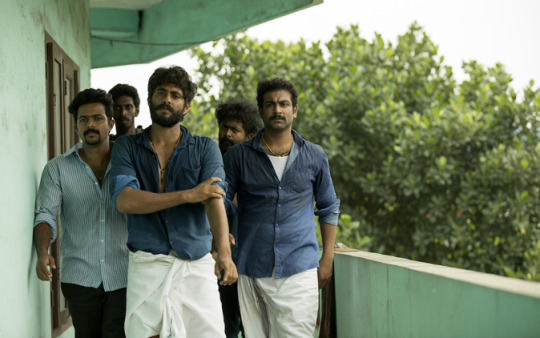
A hard movie to love, to keep close to you and revisit like an old friend when you need a warm fuzzy feeling, but instead a movie to be in total utter awe of. It’s just about two rival gangs in the pig-meat business in small town Kerala acting like a bunch of knuckle-headed morons over the course of two hours, but you’d be hard-pressed to find another piece of work on Earth this year as alive and in love with the craft of cinema as Angamaly Diaries. Every camera movement is a marvel, every line of dialogue sparkles with intimate hilarity. The violent action sequences make you shudder (almost as much as the haunting pig squeals in the dirty abattoirs), the idiotic behaviour of these bored, uneducated men makes you cringe and laugh in equal measure, and then the closing 15 minutes; a breathtaking single-shot sequence that weaves in and out of a thundering religious parade, into the side streets and drinking dens of the town, tripping over washing lines and street dogs on the way, and then ending in a horrific yet ingenious death. It’s really something you have to see to believe. It makes me so happy that in 2018, after 3D and “4D”, virtual reality and a thousand other gimmicks have tried to steal our attention, there is still nothing as impressive as a filmmaker who just needs cameras and sound to make our jaws drop.
So those were my faves from 2017. Shout outs to A Death in the Gunj, Munna Michael, Aramm and Rangoon for also being brilliant, and my apologies to the Marathi and Bengali film industries for their shitty digital distribution that means I still miss many great films each year. I’d love to know what your picks are, and I’ll see you next year :)
#best of 2017#indian cinema#bollywood#kollywood#pakistani cinema#lollywood#tamil cinema#malayalam#telugu#arjun reddy#angamaly diaries#fidaa#sai pallavi#meyaadha maan#ammy virk#punjabi#help me durdana#punjabi nahi jaungi#gujarati#vishal#thupparivaalan#dulquer salmaan#oru mexican aparatha#india#desi#indian movies#urwa hocane#Humayun Saeed#karsandas pay & use#best indian movies 2017
628 notes
·
View notes
Text
THE MOST INTERESTING INDIAN FILMS OF 2016

Critical writing should attempt to be somewhat objective, to rationalise and give meaning to one’s opinions, but with cinema that is impossible. Cinema deals with emotions and with humanity, very far from rationality.
To discuss the “quality” of cinema over an arbitrary 52-week period seems ridiculous, as the Indian film calendar doesn’t have the formal book-ending that the Oscars awards season gives to Hollywood (though we do have the masala noise-fest of Sankranti/Pongal movies in the early months, and the all caps BOLLYWOOD event movies of Diwali, Eid & Christmas into the second half of the year). Yet over the last 52 weeks, Hindi cinema in particular seems to have succumbed to the cold and clinical idea that we should be told exactly how to feel and when to feel it, using sound and image for little more than a beginning-middle-and-end, setup-problem-resolution, with well-oiled emotional propaganda like Dangal, Airlift and Pink. These “good” films were full of rationality in their storytelling. A rationality based on rules, commerce and market testing. You are able about to say what they are “about” in one word.
So the following films are those that I found most rewarding, as they dared to be irrational. Confusing. Irritating. Sometimes boring. These are films that perhaps accidentally, embraced a spirit of anarchy and looked both inward and outward, works that felt both a sense of being inside and outside “cinema”. We know now what it means to be “good” in terms of movie making. Good camerawork, good direction, good screenwriting - these things have now been defined. All the films in this list have these features, so I will attempt not to write about them. These are the films that used those tools to do something more than tell a story.
9. Achcham Yenbadhu Madamaiyada

A. R. Rahman’s stunning song from this soundtrack, Thalli Pogathey, has a lot in common with the film itself. No chorus, no refrain. A run of melodies that never repeat, yet still never deviate from a common emotion or feeling, that layer on top of one another and build to a explosive and confusing climax. Then before you know it, it’s finished. Incidentally, the song plays over a car crash.
A film with great respect for the laws of genre, but no respect for keeping them clean and intact. Boy meets girl. Boy convinces girl to go on spontaneous picturesque road-trip. Road-trip turns into insane gangster chase movie. Then the resolution of the story is so wild it might as well be from a different film, while cramming as many Tamil pop-culture movie references as possible into a five minute scene.
The most stimulating thing about the film is trying to work out just how seriously it is taking itself. Depending on which end of the spectrum you answer that question, it’s either a work by a filmmaker brave enough to break every last rule and still attempt to make us feel something, or a mocking criticism of the idea that anyone ever thought it possible to even try.
8. Bambukat

Punjabi cinema continues to be thrilling, creating its own language that is near impossible to pin down. A film like this, that tells a simple and unambiguous, almost proverbial tale, seems out of place on a list like this that celebrates the subversive. But there is something more at play.
The Punjabi cinema of the last 10 years has blossomed when at its most Punjabi. Initially, this cinema was very clearly language-based; stage play-esque comedies that relied on accent, wordplay and slang. But now, a love for the soil, people and culture of Punjab has created something amazing. When you love and respect everything around you, the air, the light, the sound of the wind, what better medium is there to express it than cinema? And this is true cinema. The story of two men battling it out to have the best motorbike is a gilded washing-line on which to hang these small details, these beautiful paghs and parandey.
7. Ae Dil Hai Mushkil

Usually, the thundering act-of-god is a disappointing deal breaker in films about people and the consequences of their actions (read: the car crashes in Cocktail and Kapoor & Sons), but the twist works in this film. It is the classic Bollywood trope of tragedy. Ae Dil Hai Mushkil is melodrama itself, from a filmmaker who has huge love for this very Indian art form.
Aside from Bhansali, which other contemporary director still explores the meaningless calamity of human existence with such poetry and romance, and such disregard for being concise? The characters of this film are people with nothing real to worry about, who create their own problems without meaning to. And then that twist, wherein they realise even the worst thing God can throw at you is nothing compared to what you can throw at yourself.
Cinema shouldn’t attempt to answer questions. It should use camera and sound, abstracts like music, poetry, colour, and other fundamentally absurd components of popular culture, and pose questions with them.
6. Action Hero Biju

Is cinema an honest medium? Is it ever possible to capture truth on camera?
Action Hero Biju seems on the surface to be trying. A documentary-esque non-narrative casebook of events in one charismatic policeman’s life. With characters etched in such succinct detail despite appearing on screen for a matter of minutes, moments of devastating melancholy juxtaposed with sudden roaring humour, moments of stillness and observation ended with crowd-pleasing fourth wall-breaking masala punches, and a camera that roves like an escaped chicken in a bustling street market, this is as honest a film as you will ever see.
5. Maheshinte Prathikaram

Another film about people, the world they inhabit, and the things they do inside it. The mood and texture of this particular world, and the way in which it is communicated to us, is entirely singular. It’s all just chance.
The crux of this film, and any small trace of “narrative” that exists within, is just a random chain of banal events, a farcical demonstration of the butterfly effect involving some dropped coconuts and a slapstick street brawl. What we’re left with is a film that laughs at the idea of reason, at the idea of originality of thought. Some films are brave enough to be about many things at once. Others are even braver to dare to be about nothing at all.
Yes it is superbly shot and directed, with beautiful characters and performances, but more importantly it is a film that whispers to you softly, as warm water rushes around your feet, and you aware of just what it is to be alive.
4. Kali

Speaking of films that are “about” things, we have Kali (Rage); a film that can be read as another interesting exploration into the Indian 2-act structure (pre and post-interval), or a moody exploitation thriller about a road trip where everything goes wrong (and isn’t the genre of exploitation such an interesting thing for any audience to think about?), or most interestingly, a cubist dissection of anger as a concept (as emotions are to cinema what light is to painting).
Then you have Sai Pallavi as a centerpiece, an undeniably wonderful actress and bonafide icon who,in 2015’s Premam, became the focus of a film about the male gaze and subsequently held the gaze of every male in the South of India. Now she is the partially seeing-eye of the narrative, and it is through her gaze and her experience that we feel the wrath of male anger weighing down on us.
In the opening of the film we are treated to a character establishing flashback, a giant brawl on a college campus, shot with a biblical audacity, iconoclastic gait. In this testosterone-fueled pure masala moment, we realise how “masculinity” is rage, and how rage is, in turn, masala cinema.
3. Kadhalum Kadanthu Pogum

The hardest film to write about in the list. A film with a sense of purpose in its craft, but that left me wonderfully confused. Is it just a drama about two people from two walks of life attempting to understand each other and define the (sexual or non-sexual) attraction they both hold? Is it Shakespearean farcical comedy of errors? Is it an ode to a wasted life - a sighing, weary half-warning on chasing an idea of excitement that is peddled to the poorest, stupidest people only to disappoint them and leave them with nothing?
There are films in this list that are about “issues” that affect people, where people die, and that guilt us into change with swathes of sadness. But this may be the saddest film of the lot, as it is ultimately pathetic and hopeless. You laugh at its protagonist, a failed gangster who has given up on trying to intimidate anyone and just slumps around, barely bothering to be alive. But it is a dangerous laughter, because doesn’t that person exist somewhere inside all of us? We are offered catharsis, even something of a happy ending, but like every other moment here, it is softly lined with utter nothingness. That nothingness comes from the performances, from the mood, from the camera, which ironically fill every second with great life and detail.
How powerful it is to speak with such purpose about having no purpose.
2. Kammatipaadam

A truly scholarly work, that on a first viewing could be seen to be a slow-moving collection of vignettes that add up to some dramatic character arcs.
But this is more than a film. It is a dense and academic study of a particular socio-political moment in time, where a city was gentrified and “developed” at the expense of its most loyal and loving inhabitants, whereby they were not fought with, but lied to, manipulated, and swallowed up by the belief that they were being helped. It is a study of an intricate and contradictory caste system, and the way it was abused and controlled by those above it to enslave the people within it.
But the film doesn’t shout these things at you. In fact it doesn’t even whisper. It just happens. And you might not even notice it if you don’t read a few essays and historical books. That is how slight and personal a work this is.
1. Sairat

Then you have Sairat, which covers similarly socially important subject ground as Kammatipaadam, with considerably less subtlety.
But both are valid forms of expression. In fact, Sairat is proud to manipulate you. It makes no secret of it. It does poke and prod you, and put things in front of you and ask you to answer to them, as if you are an active participant in such horrors. But it builds on you slowly, it creeps up on you, lulls you into rhythms and then wakes you up at random, sometimes with loud bangs and sometimes, even more unnervingly, with tiny scratches. This is something I’ve never felt before in a film.
To say simply that the pre-interval half is filmi escapism, complete with the colourful and musical diversions that make popular cinema popular, and that the second half smacks you in the face with cold and silent “realism”, would be true but over-simplified. The second half, as quiet as it is, still sings to you. It is still untrue, still cinema in an equally calculating and designing mode. Just perhaps a less enjoyable one.
Then the ending. Preachy and heavy handed, maybe. Soul crushing, certainly. But after three hours of being massaged, of feeling the warm hands of cinema all over your body (with varying degrees of lightness and heaviness of touch), to be suddenly left with this devastating nothingness, this void of humanity, is an experience. It may sound trite, but in this moment you realise that we are all at danger of being nothing but a passive audience to our own lives. Sense of self, pride in an abstract sense of community, social class – those are the biggest manipulations dished out to us by each other. To say Sairat is about caste is too easy. It is about all the hateful lies that have ever killed love.
-------------------------------
Thank you and see you next year. For the record I also loved Kabali and Befikre, but wanted to maintain some air of respectability and was ultimately unable to justify my divisive love. Does that make me a failure? On that note, I shoudn’t even mention my feelings for Housefull 3. Whoops I think I just did...
#india#bollywood#desi#achcham yenbadhu madamaiyada#indian cinema#best of 2016#malayalam cinema#malayalam#kollywood#tamil#tamil cinema#ae dil hai mushkil#ranbir kapoor#anushka sharma#aishwarya rai#hindi#sairat#marathi#rinku rajguru#dulquer salmaan#nivin pauly#kammatipaadam#punjabi#ammy virk
40 notes
·
View notes
Note
Hi I really like your tumblr page some of the stuff you post are rlly funny 😂 other than film, do you mind me asking what are your other hobbies and interests?
Aw thank you so much!! My other interests are Babbu Maan, Drake, hummous, iddaiyappam, and multi-coloured nehru jackets. Hope that answers your question.
2 notes
·
View notes
Note
love your reviews!! super funny and smart
Thank you very much!!!!! Please get me a job pls love u
0 notes
Text
INDIAN MOVIE THOUGHTZ 2K16

Ho Mann Jahaan
The thing is, this is clearly not cinema. It is shot exactly like a TV soap (like it really doesn’t matter where the characters are actually standing because all you ever see is close-ups of their faces) and is entirely dialogue based, essentially a three hour long series of static conversations. BUT as a piece of Pakistani popular culture this is a gorgeous, meaty product, full of meta-references to Coke Studio, remixes of Ghazals, constant toying with the idea of a “modern” Pakistani identity, and of course the Goddess Mahira Khan just doing stuff and saying words.
Tharai Thappattai
I’m probably the world’s biggest and most loyal Bala fan but even I must admit that the frantic, epileptic fit of loud violent tragedy that consumes the second half of this film was a LOT to take in. But then again, Bala is a filmmaker who deals in aesthetics. Often this film looks cheap, over-coloured, visually crass. But there is a great beauty in this. As Sasikumar (surely one of the most interesting “stars” in South Indian cinema – not good, not bad, just interesting) murders all these baddies in a ridiculously gory windswept final showdown in a barren wasteland, blood streaming down his face into his giant beard, there is a very Indian, very Hindu iconographic visual sense at play here, and for all the tonal problems in this movie, there are 10000 other interesting things to make up for it. Bala is an auteur, not one like Satyajit Ray or Adoor Gopalakrishnan who are dubbed great artists because they make films so boring that there is no feasible way they gave a crap about what the audience thought, but a singular creative force who expresses his own character more through his artistic output than he could in a thousand interviews.
Wazir
Pointless. I’ve seen a million “worse” films than this, but at least they gave me something to say.
Nannaku Prematho
If you’re gonna make a stupid masala film, make it as damn stupid as possible. My god, there was a subplot about a car full of a rare breed of Hamster and the car is driving at a million miles an hour and the hamsters are flying around in the boot but then TWIST it turns out they were just REGULAR HAMSTERS THE WHOLE TIME. And there is a song that is a funky ode to stalking. And I saw this at a cinema full of excited local Telugu boys and it was a genuine spiritual experience.
Kathakali
I went to see this because I want the low-key Tamil action-noir starring Vishal to become its own genre (basically remaking Paandiya Naadu over and over again with a slightly different story - like the Byomkesh movies in Bengali) but this was not very engaging and just as crap as Paayum Puli.
Ambarasariya
This is what I wanted. The Diljit movie is now officially a genre. Diljit goes around doing stuff, being funny, speaking Punjabi really fast, dancing Bhangra, getting drunk, chatting up girls, talking about turbans and dhabas, and there’s also a storyline or some shit I dunno who cares that’s not important.
Airlift
I see why these types of films are well received, but I find them trite and predictable. They play off the most dry, inartistic clinical Hollywood tropes that make me feel NOTHING. Films like this make me think that narrative cinema is a waste of time and I should just sit in galleries and watch videos of naked performance artists instead or something.
Aranmanai 2
But then you have movies like THIS, where Siddarth and Trisha (surely the most attractive on screen couple of all time) dance on a beautiful beach with their young attractive friends then an hour later Trisha is literally possessed by an evil spirit who tries to murder cute little fat kids but is later defeated by a headbanging Khushboo at a pooja that looks like a Slipknot concert. Trippier and more inventive (and actually more reflective of our societal fears and values) than that Airlift crap any day.
Mastizaade
My girlfriend keeps saying she is interested in things, pausing, then adding the suffix “academically”. Well I am interested in Sunny Leone...academically. And found this film very interesting...academically.
Irudhi Suttru/Neerja
It is magic when a film so full of cliches and predictable plot points and formulas makes you forget that what you are seeing has been done countless times before. But I connected with these films very deeply and cried and laughed and jumped and cheered at all the exact moments the filmmakers wanted me to. But I never felt manipulated. I never felt cheated.
Sanam Teri Kasam
Ridiculous, but as a meta-ode to the Mahesh Bhatt brand of swooning, chronically depressed alcoholic romance, I really liked this. In my head it is a loving parody of an under-celebrated genre, and works brilliantly.
Fitoor
Casting really is everything in mainstream cinema, and I wonder how much more this would have worked, not only artistically but also in terms of cultural impact, if there had been some better stars.
Miruthan
Unlike Airlift, where a Hollywood genre film is just made in a different language, Miruthan takes the Zombie movie and Indianises it properly. Utter masala mayhem. With zombies.
Channo Kamli Yaar Di
No-one wants Punjabi movies to be good more than me, trust me. Especially when a truly regional star like Neeru Bajwa gets the headline spot. A Punjabi film about a woman! I was so so excited. But its actually really rubbish so lets all move along now and never talk about it again.
Sethupathi
This works as an experiment. A masala movie without the masala. A leaner, shorter version of a crowdpleasing whistle-fest with no “unnecessary” songs, romance or comedy. Still the excitement of watching an Indian film remains (it was playing in a Sri Lankan restaurant where I was blind drunk with my best friend and we screamed the place down when the hero’s little son threatens the villains with a gun - MASSSS!!!) , but there is an uncomfortable Western “logic” to the storytelling. Have we really developed the art of cinema over the last 100 years just to be making things shorter, more precise? In a World where time and money are suffocating us all, now is the time for madness. I’m not sure how I feel about this film.
Puthiya Nayamam
Good to see Nayanthara get a lot of screentime and a chance to actually act as a character, but the scenes of sexual violence are really uncomfortable to watch, and very gratuitous. Then you think you the film redeems itself as the woman becomes the hero of the film and gets her revenge, but then *facepalm* it was actually her bloody husband doing all the work and he’s the real hero ok thanks bye had enough of this crap.
Jai Gangaajal
YES! A KICKASS MASALA MOVIE THAT WORKS WITHIN THE CONSTRUCT OF AN INDIAN POLICE MOVIE WHILE SIMULTANEOUSLY DISASSEMBLING THE GENRE WITH A BRILLIANT FEMALE CHARACTER AT THE CORE AND NEVER DESCENDING TO PATRONISING MALE-LED DISCUSSION ON FEMININITY. WHAT A TIME TO BE ALIVE.
Ardaas
Badly directed and squeamishly melodramatic, but great to see a film about Sikhism that isn’t propaganda. There is a brilliant movie hidden away somewhere here.
Kapoor & Sons
A nice watch, that eventually descends into mawkishness. But Alia Bhatt is the best actress in India. Like better than Deepika, better than Parineeti, better than Nandita Das, I don’t give two shits what anyone else thinks. I have a theory that maybe because she isn’t the sharpest tool in the box, she has a gift for being able to emotionally disconnect from any sense of self and totally become someone else on screen. What do you reckon? Please contact me at [email protected]
Rocky Handsome
I love a good B-movie that doesn’t try to be anything more. How can you be mad at a film like this? The film doesn’t care. It just exists. Be more like the film. Just exist and have fun and cry while taking drugs in Goa in the rain.
Kshanam
Not exactly terrible, but uncinematic and cliched (not in a good Sanam Teri Kasam way, but in a bad American TV movie way). This film only got a lot of praise because its in Telugu yet doesn’t have a song in the Swiss alps or a renegade policeman murdering 90000 villains with a single stomp of his foot.
Sardaar Gabbar Singh
Talking of films that have songs in the Swiss alps, this has two. And the renegade policeman does murder villains with a single stomp of his foot. In fact, he pretty much commits genocide. He wipes out half a bloody village. This film has been critically slaughtered and I’m not sure why. Perhaps it has something to do with the political significance of Pawan Kalyan which goes slightly over my head, because as far as I can see, this is a gloriously braindead, almost freeform collection of masala “moments” with some vague story stringing it all together. The final showdown is like the cinematic equivalent of Dubstep; our hero goes begging for forgiveness from the villain like a little BITCH and even does an amazing dance for him pretending to be a girl and takes a barrage of belittling insults but you KNOW he’s just biding his time before he goes apeshit. You’re waiting for the drop. And it goes on and on and on and you’re SO EXCITED for him to kick off. Then the villain sticks his foot out and tells our hero to kiss it. And THEN the villain’s henchman sticks HIS foot out and says “you have to touch the bull before you can get to lord Shiva” and all the hero’s friends are standing around crying thinking he’s actually gonna be a little bitch and the whole village is doomed then BOOOOOOM HE ONLY GOES AND BLOODY SHOOTS THE FOOT WITH A GUN THEN KILLS LOADS OF PEOPLE FOR HALF AND HOUR the end. Sorry I got carried away and forgot what my Dubstep metaphor actually meant.
Thozha
The setting of modern day Chennai removes the gross underlying racism of the French original (as all the characters are the same colour here) and poignantly highlights the class issues that are at the heart of this story. Good old fashioned Indian melodrama.
Theri
In a sold out show at a West London multiplex, the excited local Tamil boys who removed their shirts to fling them above their heads when Illaiyathalapathy made his entry screamed and cheered and whistled at a scene where our hero has cut off the willy of a rapist and hung him to death. This isn’t a “good” masala film (the tropes of the genre do not co-exist with any real mood, characterisation or underlying theme), but we still feel things; anger, sadness, satisfaction. This is an exploitation film; we live through the hero as he crucifies villains who symbolise various societal ills, playing out a twisted vigilante fantasy that lives somewhere within us all. It’s hard not to get caught up in it all, especially amongst a crowd who throw confetti when the first song starts. Does every masala film need to be “good”?
#ho mann jahaan#pakistan#pakistani#mahira khan#pakistani cinema#lollywood#tharai thappattai#sasikumar#bala#tamil#tamizh#kollywood#tamil cinema#illayaraja#wazir#amitabh bachchan#farhan akhtar#bejoy nambiar#aditi rao hydari#bollywood#bollywood review#hindi#hindi cinema#nannaku prematho#jr ntr#telugu#tollywood#telugu cinema#rakul preet singh#kathakali
9 notes
·
View notes
Note
your reviews are amazing oh my god your singam 2 one killed me
thank you! yeah not gonna lie that shit was funny. keep in touch x
1 note
·
View note
Text
THE 10 MOST INTERESTING INDIAN FILMS RELEASED IN THE YEAR OF 2015
Oh, Indian cinema. It is so fascinating to watch you evolve. Perhaps the only popular cinema on Earth that still rebels against the narrative vocabulary so aggressively imposed as “good” by Hollywood and the West, yet now confident enough to constantly dismantle both those ideas and formulas along with its own, creating something new in the process every time.
As much as the World’s media would like you to believe, our film culture is not defined by Bollywood and Shahrukh Khan. I saw more than 100 Indian films over the last 12 months, many good and many awful, but the social and political climate in which movies are being made, a world in transit pushing against the force of globalisation, makes pretty much all of them a thrilling and challenging watch. These ten films listed below are those which assessed the language of storytelling, whether embracing or dismantling the “rules”, and really managed to say something. Enjoy!
10. Judge Singh LLB

Modern Punjabi cinema is a movement in itself just by existing, but this little film represents more than just a growth spurt in a once-dormant regional industry. The true spirit of independent cinema is alive in Judge Singh LLB; charmingly scrappy production values and an earnest creativity that rises above technical and budgetary restrictions. This is the same energy we saw in the sudden flurry of new-age Tamil comedies a few years ago (Naduvula Konjam Pakkatha Kaanom, Soodhu Kavvum etc.) where a filmmaker can be felt simultaneously satisfying their own creative impulses while tirelessly serving the audience something entertaining. Every over-exposure, every shaky GoPro shot, every slightly awkward cut, is easily forgiven when intentions are this good. And with a script so insanely fun, that seamlessly fulfills being both a gripping thriller and a slapstick comedy, (a bumbling work-shy law grad is forced to fight a controversial murder case to win over his bride – tell me you don’t wanna see this!), you may not even notice anyway.
9. Su Su Sudhi Vathmeekam
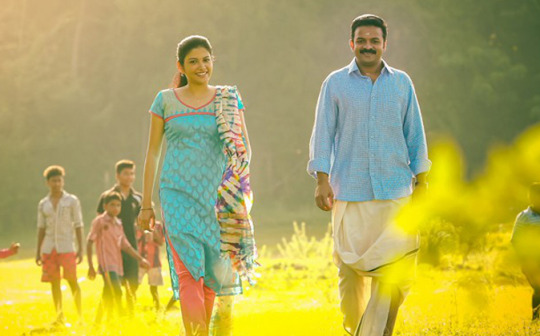
Malayalam cinema is officially in a league of its own, and I could have easily written a top 10 list of films from Kerala, with this one being the summation of everything that’s making it great at the moment. While visually unassuming, this tale has one of the largest ensemble casts seen in a film this year, and beautifully manages to make every character a complete person. With a different director or writer, this could have been a confusing and directionless mess of subplots and narrative dead-ends, but in these capable hands it becomes a tapestry of human life, with this colourful array of people weaving their way in and out of our hero’s journey in a way all of us experience in our realities. Another brilliantly character-centric Malayalam film this year, Amar Akbar Anthony, imploded in on itself when it frantically tried to be about something in its last 20 minutes. Here, we are spared a similar fate, quite miraculously when considering the moralistic ‘feel-good’ (ugh) potential of the story of a simple man overcoming his speech impediment. His disability doesn’t define his character. Sure, it means that themes of self- confidence, societal attitudes to the “other” and the power of determination are all tackled, but the main triumph is that this is just a film about humans, and everything that comes with being one.
8. Piku

After the last few years of commercial Hindi cinema, it seems repetitive and patronising to talk about “women-centric films” in the same way we did when Vidya Balan was the biggest name in Mumbai. Yet this is not a film about being a woman, or how hard it is to be a woman, or how women can smoke and drink and fuck and no-one should judge them. In fact, it’s a film about family, old-age, and our attachment to the idea of home. The fact that the our main character happens to be woman, a complex bundle of charm and erratic mood-swings and wonderfully polished grey-areas, as far from being two dimensional and as close to being a living breathing human as is possible on screen, is simultaneously inconsequential and revolutionary. The heroines of Tanu Weds Manu Returns and Queen, lauded for their feminist subtext and superbly performed by the face of new “women-centric Bollywood” Kangna Ranaut, are essentially caricatures. They are types. Piku is not a type. Sometimes she’s a bit of a grumpy asshole. And then sometimes you’ll wish she was your best friend. She’s totally unpredictable, yet will remind you of yourself and everyone you have ever met. This detailed dialogue-heavy character study of a frustrated single woman and her relationship with her needy father became one of the biggest hits of the Hindi box office this year. Don’t confuse corporate figure-mongering with genuine audience approval – Piku was a triumphant and unexpected phenomenon, and this is something to celebrate.
7. Kunjiramayanam

We have a problem with comedy in mainstream Indian cinema. The genre is defined by broad, unfunny slapstick outings (personified by the films of Sajid Khan and his Housefull series) or crude sexual innuendo (Grand Masti, Kya Kool Hain Hum), and in the South, comedy is usually relegated to a “track” in a film with a simultaneous, much more serious story-line, or simply diluted with jarring and unnecessary melodrama and emotion. So we return to the Malayalam screen, which has now given us the Perfect Indian Comedy Film™. Doused in local flavour and a beautiful sense of time and place, the humour of the film (lightheartedly satirising small-town India’s obsession with ritual and superstition) is purely situational, which means that the huge cast of characters are allowed to become really lovable, and feel like close friends by the time the credits roll. The film is so funny, and so untarnished with anything other than actual comedy, that you may actually miss how well written some of the relationships are, and the cinematic and visual finesse with which it has been shot. However first and foremost, this is a stupid film about stupid people, and simply one of the finest ones India has ever produced.
6. Nirbaak

Placing this film in any canon or cultural trajectory is difficult. It’s too much fun to be considered “parallel cinema” (the tag given to mostly joyless and dour “realist” Arthouse Indian film), yet too genre-less, too obviously crafted from the mind of an auteur, to be placed into any other box. This is cinema about cinema, and not in the way you’re thinking. It is cinema about the craft of cinema, using image and sound (not words) to create meaning. Four stories, including one about a tree in love with a woman and another about a coroner in love with a corpse, communicate some really damn deep questions about the nature of human emotion. Is it possible to be in love with yourself? Can attachments to inanimate objects ever been considered as love? Is jealousy a form of love? There is hardly any dialogue, just brilliantly composed images, wonderful visual storytelling and some powerful sound design (struggling to remember another instance this year where I even noticed sound design in an Indian film), yet we are forced to think about the very feeling that defines every member of our species. A work of genius and poetry.
5. NH10

I love it when a recognisable Western genre is perfectly Indianised. I find it a fascinating process, seeing what needed to be added, subtracted and adapted in a formula to allow it to sit comfortably in an Indian movie theatre. Here we have the horror-thriller genre, I’m thinking of films like Donkey Punch and Eden Lake, that start off as normal dramas before slowly descending into terrifying disaster, horrifying because “It Could Happen to You”. There are homages played to various western genres (most obviously Anushka Sharma’s Kill Bill yellow-esque jacket she dons while literally slashing the patriarchy), but the film plays on very Indian fears and themes. A middle-class metropolitan couple find themselves violently embroiled in an honour-killing in a rural wasteland while on their way to a luxurious retreat, and in one short, economically taught thriller, the uncomfortable gaps between India’s rich and poor, cities and countryside, even men and women, are exploited to brilliant effect. Taken at its most rebellious, the film is a warning to the new designer handbag-wearing class of Indians that they are not safe in their high-rise towers from the lawless madness of “Real India”, or perhaps an aggressive call to arms to women either side of the class divide, united by the sexism, though various in its forms and degrees, that unfortunately defines their existence in modern India. The most valuable lesson of NH10 though, is that much more than monsters or ghouls, it is human beings that are the most horrifying.
4. Masaan

For each film in this countdown, I’m attempting to assess a film’s cultural impact, its cinematic value and also what it is actually about, but I can’t do any of this for Masaan. It is a gorgeous slice of poetry that will wash over you like ocean waves, affecting you deeply in ways you are unable to explain. Two simple stories of life and death, told with a remarkable flair, remarkable in the fact that it immerses you into a trance-like state, forgetful of the fact you are even watching a film. It has the ethereal pace of a dream, visually and sonically intense, reminiscent of reality but somehow detached from it. The narrative threads are simple and don’t require description, yet it is also impossible to tell you what this film is trying to say. People talk of caste, of religion, of values, yet this is not a film with a message. It is about everything and nothing. About life and death and rebirth and love and desperation. It uses modern India as a palette of colours with which to paint a mural of the giant shitstorm that is humanity. How can one film do so much? I really have no idea, but it did.
3. Premam

Is Premam a film about the male gaze? Let’s look at the character of Malar. She is the second of three love stories that we witness in our hero's life, and she became nothing short of a real life Kerala-wide phenomenon. It’s hard to think of the last time that a fictional character dominated popular culture in such a way. She’s gorgeous of course, but not perfect (her pocked face was a major talking point). Does this satisfy some male desire for imperfection, damage limitation for potential jealousy and heartbreak and insecurity? She is unphased (though not accepting) of inappropriate, sometimes sexually aggressive behavior, and holds no qualms regarding close social interaction with males. Does she represent some deep fantasy of the repressed Indian man, constantly teased with the idea of the sexually liberated Western female? And is there anything wrong with this? The female characters are well-rounded and three dimensional and treated with dignity and respect (by the writers, not always by the male characters). For the most part, their lives do not revolve around solely men. Is it sexist that this a film about male desire, their attitudes to women and relationships? I think it’s actually mighty interesting, and it doesn’t hurt that it has some of the best casting of the year, a thrillingly uncontrollable visual force, and a tumbling free-form structure that reflects the pace of life in a way so many other Malayalam films have been nailing recently.
2. Yennai Arindhaal

Gautam Menon, master of the meta-romance, decided to dismantle the masala genre and its defining characteristic of the superhuman alpha-male, using one of Tamil Nadu’s biggest superhuman alpha-males Ajith Kumar, and in the process created one of the most sensitive, socially forward-thinking action movies I’ve ever seen. Yes, this is a crowd-pleasing blockbuster about a tough policeman taking down a criminal gang of organ smugglers, but more importantly it has an important subtext about male responsibility. The hero’s motivations revolve entirely around his daughter, but not in a mawkish melodramatic way. She is not his biological daughter. His wife had a life before him, that he completely accepts and takes with him after their marriage and never makes her feel guilty about. He is a role-model for the disgusting main characters we usually see in masala films, treating all the women in his life with unpatronising respect. At one of his first meetings with his future wife, after she has performed a dance recital, he doesn’t flirt or badger, he engages with her in conversation about her art, her interests, her passions. He wants to know her. And when he later becomes a father to her child, he does so in a beautiful way. I cried, not because these were intense emotional scenes, but because they were not. To see the most mainstream of cinema embracing single-parenthood and remarriage in such subtle, mature ways, nonchalantly embedding them into rip-roaring violent revenge thrillers with twinkling nighttime highway colour pallets and joyous song sequences and “punch dialogues”, is truly a beautiful thing.
1. Angrej
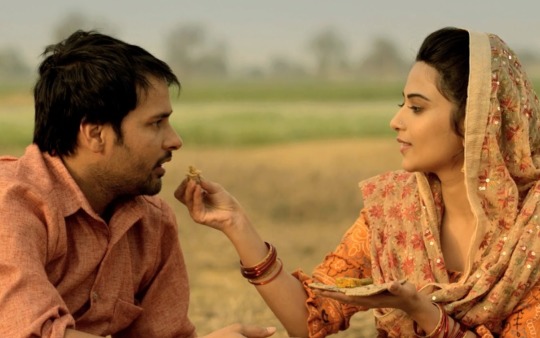
Am I giving this film more credit than it deserves because it came from the Punjabi film industry, a regional cinema that prior to this year either produced crude political propaganda or painful slapstick comedies? Perhaps. But the Punjabi-ness of Angrej is everything that makes it special. Most similar in cinematic style to the frantic rural Madurai films in Tamil from the 2000’s (Paruthiveeran, Aadukalam, Subramaniapuram, Kaadhal), with this energetic French nouvelle-vague-esque pacing, jump cut to jump cut polishing every nook and cranny of these worlds and their people, places that we aren’t used to seeing in cinema but which become effortlessly cinematic in the hands of these directors. The sheer volume of evocative images in these films makes you wonder how the hell they had enough time to shoot, but they are far from showy and gimmicky. Every scene in Angrej is beautiful, not in the way they contribute to an overriding narrative (as this is not the type of film where a story is in the least bit important), but because of the tone they establish, the hyper-specific time and place that we feel through the images, the dialogue, the music. The barely-there plot consists of a low-stakes love triangle, but through the characters and their village, their day to day lives as farmers, we think about rural India as never before. Imperialism is addressed via its absence. The story takes place during the fight for independence, but the British have no interest in this tiny community. It is of no use to them. Social norms and values are humourously satirised, a husband ashamed when his wife dares to walk so close as five paces behind him. The glorious folk culture of Punjab is documented stunningly through song sequences that melt into the very fabric of the film in a way only Indian cinema can achieve (this is not a musical), two jealous men hilariously warring through the tradition of boliyaan, melodic rhyming couplets. More than any of that, this is a film about time and society, how much yet how little we change over the years. This is cinema of the highest order. Punjabi movies have found a voice, somehow oddly close yet so thankfully far from Naughty Jatts 2.
I still feel emotional that a Punjabi movie stunned me into a wordless artistic coma. This is the thrill of being an Indian film nerd, with its boundless regional pockets, never knowing when a language or culture and its people will start a movement. I thought about movies and this list with every second my brain had to spare, and these are the ten films that lingered the longest. I really hope you enjoyed reading this, and have a wonderful 2016 where you continue to be engaged, critical and consuming plenty of art! Please let me know your thoughts, that’s what makes all this worthwhile.
Love to all xx :)
#judge singh llb#judge singh#ravinder grewal#punjab#punjabi movies#punjabi#panjab#panjabi#punjabi cinema#su su sudhi valmeekam#su su sudhi vathmeekam#jayasurya#malayalam#kerala#Malayalam Cinema#malayali#mollywood#piku#irrfan khan#amitabh bachchan#deepika#Deepika Padukone#shoojit sircar#bollywood#bollywood actress#hindi#hindi cinema#Indian movies#indian cinema#indian
175 notes
·
View notes
Text
Indian movies/thoughts (part 7)

Phantom
An odiously pointless film, which when it isn’t boring, isn’t much else either.
Paayum Puli
Pandiya Nadu was such a lovely film, released with minimal publicity and fanfare, that still endures over the behemoth Diwali releases of 2013 (because it was actually good). Hence I had high hopes walking in to Paayum Puli. The colours, the lush (yet unnecessary) background score, and the general mood of warm noir seriousness here all had me nostalgic for Pandiya Nadu, and I did manage to enjoy this silly film with that emotion alone.
Welcome Back
When you go to see a crappy film like this, you know it’s gonna be crappy so you have to get into that headspace. That headspace gave me a headache. Luckily Shruti Hassan’s denim shorts were the aspirin I needed.
Hero
A really nicely directed romantic masala movie with a satisfying story arc and some really watchable newcomers. Reminded me of Tevar in its likeable earnest film-making.
Yatchan
A forgettable bit of fun with a raucously memorable climax, starring an increasingly annoying Arya.
Maya
So many interesting little things at play here; the black & white, the meta-musing on the horror genre itself, the lovely long takes, Nayanthara’s metaphorical role as single mother. I could have written a great article on this movie (especially what it means for a Nayanthara fan, or in the wider context of women in Tamil cinema) but that would mean I’d have to watch it again and I’m not sure I could inflict that on myself.
Katti Batti
Somewhere here there is an interesting black-comedy about a futile and pathetic man who refuses to let go of his past, but it is hidden beneath a stinking pile of mawkish and dishonest emotional fluff.
Puli
Really really really weird. White people laugh at our movies all the time and their lack of understanding upsets and disturbs me. But they need to see this shit because it is strange.
Life of Josutty
A surprising one-off where a film about an emigre from India to the West becomes quite brilliant only when its cameras arrive on foreign lands! The Kerala scenes are tired and awkwardly staged, but the sense of melancholy longing that suffocates the main character when he moves to New Zealand is quite beautifully translated. A worthwhile watch.
Rudramadevi
Over-talky, unevenly scripted and at times boring, but with its thoughts on gender identity, the brilliant roles for women, and the glamorous multi-star cast (which has you exclaiming ‘Oh my God, they’re in this too?’ every five minutes), I personally found this an infinitely more exciting cinematic experience than the clinical Baahubali.
Ennu Ninte Moideen
Visually brilliant with a lovely mood, but this is a film about characters and emotions, and I felt absolutely nothing.
Jazbaa
Irrfan Khan hamming it up is great. Literally nothing else is.
Singh is Bliing
Worth watching for the crackpot genius of the song sequences alone.
Naanum Rowdy Dhaan
I mean this was a great movie, but I’m just really tired of the comedy-action-escapade genre in Tamil. There are SO many of them, and this didn’t quite transcend the genre for me.
10 Endrathukulla
This got really bad reviews, but it’s interesting how the mood you are in can affect the way you respond to cinema in the moment.Yes it was retarded, yes there are plot holes, yes it is pointless and formulaic. But I actually had an awesome time. There were so many things that I liked here, and I guess I made a subconscious choice on the day to embrace the fun and forgive the stupidity.
Amar Akbar Anthony
I love films about nothing, about ordinary life moving along as it does, but clearly it is very hard to end a film about nothing, as this stunning character piece suddenly becomes a revenge drama in its closing twenty minutes. Let down.
Ranavikrama
A great masala movie which refreshingly wastes no time in getting to the plot. The hero setting up his own police station in a barren quarry is a great set-piece, and its always nice to watch your first film of a big regional masala hero and understand their star power straight away.
Vedalam
It’s funny how the first-day-first-show claps and whistles and screams of ‘THALAAAA’ can transform an ordinary movie into a thrilling one.
#phantom#katrina#katrina kaif#saif#saif ali khan#kabir khan#paayum puli#vishal#susintheeran#kajal#kajal agarwal#welcome back#anil kapoor#shruti hassan#shruti haasan#dileep#life of josutty#rudramadevi#anushka#anushka shetty#allu arjun#nithya menen#Nithya Menon#ennu ninte moideen#prithviraj#jazbaa#aishwarya rai#irrfan khan#singh is bliing#singh is bling
4 notes
·
View notes
Text
Some musings on Shaandaar & popular cinema

How lucky are we, as those who follow and dissect the evolution of popular Indian cinema, to have filmmakers who do our work for us? Just like in the Western mainstream, our most commercial films work with templates – big money is riding on these productions and the tried-and-tested is always the safest bet – but these templates are engaged with. They are commented on, fiddled with and challenged. The film becomes less “about” the narrative (the characters, their obstacles and how they overcome them), and more about the formula itself, what it means and why it pleases us so much. I can’t think of any greater gift for a lover of cinema.
Shaandaar is a big Indian wedding movie. It relishes in the opulence of the upper-classes. In the escapist cinema of Karan Johar, we see characters for whom opulence is an unexplained normality. We are expected to relate to these people and their lavish and unattainable lifestyles for three hours, as if this is how regular people live.Shaandaar takes this familiar trope of a very specific, very Indian type of film, and engages with it. Two identical twins who talk in faux-American accents and express themselves exclusively in acronyms walk into the country manor where the film’s wedding is due to take place and exclaim “OMG, this is totally K3G!”. This uniquely Indian cultural reference tossed off in a bundle of irksome Americanisms says something about our modern aspirational values, both in our cinema and in our society. But to make this point via these twins, who dress and move and speak in tandem and in their own surreal parlance, is cinema. It’s a small idea yes, but this film is full of them. The Sindhi family who dress in gold capes and drive gold limousines and shoot golden guns make us squirm with their crassness. The casual family breakfasts that are served up with a full song-and-dance routine from the table staff are equally hilarious and uncomfortable. Frequently unsubtle perhaps, and sometimes verging on awkward when it comes to timing, but inventive ideas with lush subtext nonetheless.
The idea of beauty and pleasure is recurrent (and what is more pertinent when it comes to this escapist genre of mainstream cinema?). Femininity has always played a strange role in this type of cinema (or at least the type of cinema that Shaandaar is pretending to be), with heroines who have seemingly never had a job or an aspiration other than finding a husband, yet are flawless classical dancers and singers and clearly spend hours in the gym. We have two brilliant song sequences in the film (traditionally points where the sensual perfection of feminine energy would be celebrated) that challenge body image in some quite fantastic and unpatronising ways. Not only are there some great visual ideas and choreography (that’s the entertainment quota ticked off), but they also contribute to the narrative and character arcs as plot points develop through song (there's some fodder for the film theoreticians) and comment on and challenge societal values that are perpetuated through particular genres of mainstream cinema. Can we say the same of the new James Bond movie?
A much more literal fairytale theme resides over the whole story, with a heroine who can talk to animals and for whom rose petals fall from the sky when she walks down the stairs. I was worried this character would be something of a “manic pixie dream girl”, for whom her rejection of traditional “femininity” has been written only to pander to a particular type of male gaze, but this film knows better than that. She doesn’t “save” the hero from his own mundanity, or exist only to amuse him and allow him to seek out some great truths about life. In fact, Jagjinder Joginder is a manic pixie dream boy, and it is quite clear that these two oddballs are made for each other before they even realise it themselves. There is a delightful lack of conflict in their romance, which frees up space for the film to explore why they end up together and not the painful how. The gorgeously banal scene where they pick glue off each other’s hands must have been improvised to achieve such spontaneous intimacy. There is then a nicely disorientating jump cut to the couple nuzzled up in an armchair, giggling as they try and shove too many biscuits in each other’s mouths. The giggles then turn to an awkward silence when Jagjinder flippantly reveals his parents died in the 1984 riots, then after a moment, return to giggles again. It is so warm and so natural in its staging, devoid of any filmi mushiness and full of real emotion. Then there is that cut. Within the cut, night turns to day, and the couple go from sitting cross legged on the floor half a meter away from each other, to a familiar hug. That lovely feeling of being destined by circumstance into forced confinement with your crush, and the excitement of the inevitable hook-up, are all contained within that cut. It is magic.
Just to hammer home that this is a film about escapism and what it means in terms of our values, we have mainstream Bollywood’s first mushroom trip, a plethora of dream sequences full of teenage sexual fantasy and a number of other surreal non-sequitur titbits. The film uses tropes of commercial cinema, including the aforementioned song sequences and those little tunes on the background score that announce a character’s name when they appear on screen, to create a sustained anything-is-possible fairytale World. It is quite literally Karan Johar on drugs. There are countless moments that comment on cinema and values, but it would be tiresome to read a painful dissection of each. Shaandaar disassembles mainstream cinema to assess its societal value, using both the narrative and technical tropes of a particular genre to do so. At points the comedy falls flat, and there is some questionable writing (including a father figure who is supposed to be likable, selfishly keeping important truths from his daughter regarding her biological origins), but when there are so many ideas at play, so much cinema, perfection would have been a damn sight less interesting.
#shaandaar#alia#alia bhatt#shahid#sahid kapoor#pankaj kapoor#pankaj kapur#bollywood#hindi#desi#indian film#indian film review#hindi film#hindi cinema#indian cinema#bollywood review#shandaar
12 notes
·
View notes
Photo
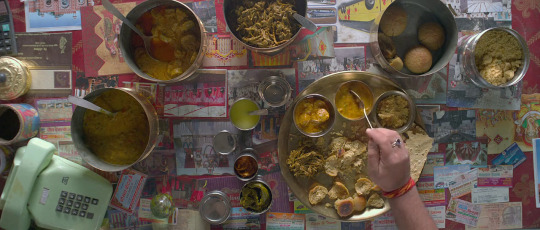

Shuddh Desi Romance (Dir. Maneesh Sharma, 2013)
#shuddh desi romance#shudh desi romance#sushant singh rajput#parineeti chopra#parineeti#maneesh sharma#Yash Raj Films#yash raj#aditya chopra#bollywood#india#indian#jaipur#indian food#curry#thali#rajasthan#food porn#desi#food
50 notes
·
View notes
